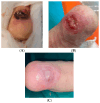Rapid, Safe, and Tolerable Healing of Pediatric Skin Injuries with Blue Light Therapy: An Observational Case Series
- PMID: 40564760
- PMCID: PMC12191267
- DOI: 10.3390/children12060801
Rapid, Safe, and Tolerable Healing of Pediatric Skin Injuries with Blue Light Therapy: An Observational Case Series
Abstract
Background/objectives: Pediatric skin injuries represent a clinical challenge, especially in cases with complex etiology or with severe pain. Blue light is an emerging technology with potential application in pediatric wound care. The aim of this case series was to describe the clinical use of blue light in pediatric patients with injuries of varying etiologies and mechanisms, and to assess its long-term effectiveness and sustainability in treatment.
Methods: Twelve hospitalized pediatric patients (0-12 years old) with skin injuries were included in this case series. The etiologies of wounds treated with photobiomodulation were incontinence-associated dermatitis, peristomal injuries, and pressure injuries. The injuries were assessed using specific classification tools and pain scales. The wounds were treated every three days using a medical device that emits blue light (410-430 nm). When necessary, wounds were also treated with appropriate dressings.
Results: All injuries responded positively to photobiomodulation therapy and showed a rapid resolution of inflammation. Complete wound resolution was achieved in 11 of 12 cases. The average healing time was 3.7 days. Four injuries achieved resolution with only one application of blue light. Scores from the pain perception scales showed that the blue light treatment was well tolerated by pediatric patients, showing high parental compliance. No side effects or adverse events were observed.
Conclusions: Blue light photobiomodulation proved to be a safe, well-tolerated, and effective technology in the treatment of pediatric skin injuries, with good acceptance by young patients and families. More structured clinical trials would be needed to validate the efficacy of blue light in pediatric injuries.
Keywords: blue light; incontinence-associated dermatitis; medical device-related pressure injuries; moisture-associated skin damage; phobiomodulation; pressure injuries.
Conflict of interest statement
The authors declare no conflicts of interest.
Figures




References
-
- McCord S.S., Levy M.L. Practical guide to pediatric wound care. Semin. Plast. Surg. 2006;20:192–199. doi: 10.1055/s-2006-949119. - DOI
-
- Ciprandi G., editor. Neonatal and Pediatric Wound Care. Edizioni Minerva Medica; Torino, Italy: 2021.
-
- Nicolosi B., Parente E., Fontani I., Idrizaj S., Stringi D., Bamonte C., Longobucco Y., Buccione E., Maffeo M., Granai V., et al. Risk Factors for Skin Injuries in Hospitalized Children: A Retrospective Study. Inferm. J. 2024;3:277–285. doi: 10.36253/if-3159. - DOI
LinkOut - more resources
Full Text Sources

